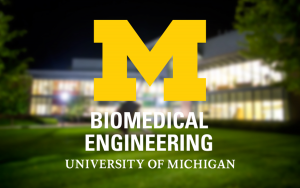Presented By: Biomedical Engineering
PhD Defense: Benjamin Juliar
Proteolytic and Mechanical Matrix Remodeling During Capillary Morphogenesis

NOTICE: This event will be held via BlueJeans. The link will be placed below.
BlueJeans Link: https://bluejeans.com/358462383
Engineering large viable tissues requires techniques for encouraging rapid capillary bed formation to prevent necrosis. A convenient means of creating this micro-vascular network is through spontaneous neovascularization, which occurs when endothelial cells (ECs) and supportive stromal cells are co-encapsulated within a variety of hydrogel-based extracellular matrices (ECM) and self-assemble into an interconnected network of endothelial tubules. Although this is a robust phenomenon, the environmental and cell-specific determinants that affect the rate and quality of micro-vascular network formation still require additional characterization to improve clinical translatability. This thesis investigates how the proteolytic susceptibility of engineered matrices effects neovascular self-assembly in poly(ethylene glycol) (PEG) hydrogels and provides characterization of changes to matrix mechanics that accompany neovascular morphogenesis in fibrin and PEG hydrogels.
Proteolytic ECM remodeling is essential for the process of capillary morphogenesis. Pharmacological inhibitor studies suggested a role for both matrix metalloproteinases (MMP)- and plasmin-mediated mechanisms of ECM remodeling in an EC-fibroblast co-culture model of vasculogenesis in fibrin. To further investigate the potential contribution of plasmin mediated matrix degradation in facilitating capillary morphogenesis we employed PEG hydrogels engineered with proteolytic specificity to either MMPs, plasmin, or both. Although fibroblasts spread in plasmin-selective hydrogels, we only observed robust capillary morphogenesis in MMP-sensitive matrices, with no added benefit in dual susceptible hydrogels. Enhanced capillary morphogenesis was observed, however, in PEG hydrogels engineered with increased susceptibility to MMPs without altering proteolytic selectivity or hydrogel mechanical properties. These findings highlight the critical importance of MMP-mediated ECM degradation during vasculogenesis and justify the preferential selection of MMP-degradable peptide crosslinkers in the design of synthetic hydrogels used to promote vascularization.
Matrix stiffness is a well-established cue in cellular morphogenesis, however, the converse effect of cellular remodeling on environmental mechanics is comparatively under characterized. In fibrin hydrogels, we applied traditional bulk rheology and laser tweezers-based active microrheology to demonstrate that both ECs and fibroblasts progressively stiffen the ECM across length scales, with the changes in bulk properties dominated by fibroblasts. Despite a lack of fibrillar architecture, a similar stiffening effect was observed in MMP-degradable PEG hydrogels. This stiffening tightly correlated with degree of vessel formation and critically depended on active cellular contractility. To a lesser degree, deposition of ECM proteins also appeared to contribute to progressive hydrogel stiffening. Blocking cell-mediated hydrogel degradation abolished stiffening, demonstrating that matrix metalloproteinase (MMP)-mediated remodeling is required for stiffening to occur. EC co-culture with mesenchymal stem cells (MSCs) in PEG resulted in reduced vessel formation compared to fibroblast co-cultures and no change in hydrogel mechanics over time. The correlation between matrix stiffening and enhanced vessel formation, and dependence on cellular contractility, suggests differences in vessel formation between fibroblasts and MSCs may be partially mediated by differences in cellular contractility. Collectively, these findings provide a deeper understanding of mechanobiological effects during capillary morphogenesis and highlight the dynamic reciprocity between cells and their mechanical environment.
Chair: Dr. Andrew Putnam
BlueJeans Link: https://bluejeans.com/358462383
Engineering large viable tissues requires techniques for encouraging rapid capillary bed formation to prevent necrosis. A convenient means of creating this micro-vascular network is through spontaneous neovascularization, which occurs when endothelial cells (ECs) and supportive stromal cells are co-encapsulated within a variety of hydrogel-based extracellular matrices (ECM) and self-assemble into an interconnected network of endothelial tubules. Although this is a robust phenomenon, the environmental and cell-specific determinants that affect the rate and quality of micro-vascular network formation still require additional characterization to improve clinical translatability. This thesis investigates how the proteolytic susceptibility of engineered matrices effects neovascular self-assembly in poly(ethylene glycol) (PEG) hydrogels and provides characterization of changes to matrix mechanics that accompany neovascular morphogenesis in fibrin and PEG hydrogels.
Proteolytic ECM remodeling is essential for the process of capillary morphogenesis. Pharmacological inhibitor studies suggested a role for both matrix metalloproteinases (MMP)- and plasmin-mediated mechanisms of ECM remodeling in an EC-fibroblast co-culture model of vasculogenesis in fibrin. To further investigate the potential contribution of plasmin mediated matrix degradation in facilitating capillary morphogenesis we employed PEG hydrogels engineered with proteolytic specificity to either MMPs, plasmin, or both. Although fibroblasts spread in plasmin-selective hydrogels, we only observed robust capillary morphogenesis in MMP-sensitive matrices, with no added benefit in dual susceptible hydrogels. Enhanced capillary morphogenesis was observed, however, in PEG hydrogels engineered with increased susceptibility to MMPs without altering proteolytic selectivity or hydrogel mechanical properties. These findings highlight the critical importance of MMP-mediated ECM degradation during vasculogenesis and justify the preferential selection of MMP-degradable peptide crosslinkers in the design of synthetic hydrogels used to promote vascularization.
Matrix stiffness is a well-established cue in cellular morphogenesis, however, the converse effect of cellular remodeling on environmental mechanics is comparatively under characterized. In fibrin hydrogels, we applied traditional bulk rheology and laser tweezers-based active microrheology to demonstrate that both ECs and fibroblasts progressively stiffen the ECM across length scales, with the changes in bulk properties dominated by fibroblasts. Despite a lack of fibrillar architecture, a similar stiffening effect was observed in MMP-degradable PEG hydrogels. This stiffening tightly correlated with degree of vessel formation and critically depended on active cellular contractility. To a lesser degree, deposition of ECM proteins also appeared to contribute to progressive hydrogel stiffening. Blocking cell-mediated hydrogel degradation abolished stiffening, demonstrating that matrix metalloproteinase (MMP)-mediated remodeling is required for stiffening to occur. EC co-culture with mesenchymal stem cells (MSCs) in PEG resulted in reduced vessel formation compared to fibroblast co-cultures and no change in hydrogel mechanics over time. The correlation between matrix stiffening and enhanced vessel formation, and dependence on cellular contractility, suggests differences in vessel formation between fibroblasts and MSCs may be partially mediated by differences in cellular contractility. Collectively, these findings provide a deeper understanding of mechanobiological effects during capillary morphogenesis and highlight the dynamic reciprocity between cells and their mechanical environment.
Chair: Dr. Andrew Putnam